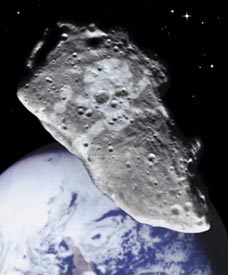
Near-Earth asteroids pose a threat to our planet.
S&T illustration by Steven Simpson.
While politicians have only recently begun to take serious interest in possible impacts by near-Earth asteroids (NEAs), astronomers have been trying to gauge the magnitude of the impact threat for decades. Two new analyses, presented yesterday at the American Astronomical Society's Division for Planetary Sciences meeting, hint that our planet may not be in quite as much danger as previously thought.
A colliding asteroid at least 1 kilometer across would wreak havoc on a global scale, so these are the objects that astronomers want to find and catalog most urgently. More than 600 NEAs of this size have been found, but it's unclear how many remain unseen. Based on the discovery rate to date, dynamicists estimate that the total population probably ranges from 800 to more than 1,200.
But each new find divulges only its brightness — astronomers must then guess its diameter and mass, and to do so they typically assume an object has an albedo, or surface reflectivity, of 11 percent. But after carefully studying the spectral properties of many NEAs, J. Scott Stuart and Richard P. Binzel (MIT) conclude that the average Earth-crosser has an albedo several percent higher, which means that objects of a given brightness are likely smaller than thought. So the good news, Stuart concludes, is that the total count of 1-km NEAs may be close to the low end of estimates, nearer to 800.
The bad news, however, is that one subgroup (known as D-type asteroids) could be much darker — and thus more numerous — than thought, especially if they are the extinct comet nuclei masquerading as asteroids. For example, the nucleus of Comet Borrelly has ultrablack patches that reflect just 1 percent of sunlight. If all D asteroids are like Borrelly's nucleus, Stuart explains, then the census of 1-km NEAs would climb by several hundred.
It doesn't take a big asteroid to cause a lot of damage, however. Impact specialists are quick to note that the Tunguska event of 1908, which leveled some 2,000 square kilometers of Siberian wilderness, was caused by an interplanetary intruder no more than about 60 meters across. Telescopic surveys surveys occasionally sweep up NEAs this small, but not very often. So estimates of their total population (and thus how often they strike Earth) are very uncertain — the best estimates suggest a collision every every 100 to 300 years.
Alan W. Harris (Space Science Institute) thinks the threat from Tunguska-size impactors isn't as great as thought. He has simulated the population of small NEAs using discovery statistics from the LINEAR telescopes in New Mexico. "It's like guessing how many black jelly beans are in a big jar," Harris explains, by throwing in a handful of red ones (the discovered objects), mixing them all up, then seeing how many red ones are in each subsequent handful. LINEAR has spotted a few dozen Tunguska-class NEAs, and from that Harris concludes that there must be about a half million of them in all. That means we can expect one to hit Earth every 1,000 or 2,000 years. "That makes the Tunguska event quite rare, compared to its statistical likelihood," Harris notes.
 0
0
Comments
You must be logged in to post a comment.